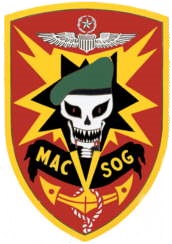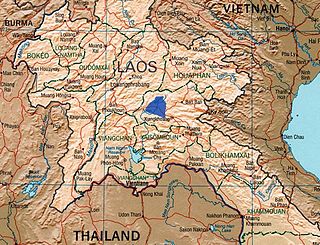
Military Assistance Command, Vietnam – Studies and Observations Group (MACV-SOG) was a highly classified, multi-service United States special operations unit which conducted covert unconventional warfare operations before and during the Vietnam War.
Operation Hardnose was a Central Intelligence Agency-run espionage operation spying upon the Ho Chi Minh trail that began during the Laotian Civil War. Started in Summer 1963, it soon attracted the attention of the U.S. Secretary of Defense, Robert McNamara. By December 1963, he was calling for its expansion. Operation Hardnose expanded and continued to report on the Ho Chi Minh trail even as American military intelligence activities mounted against the communist supply artery. In an attempt to adapt technology for use by illiterate Lao Theung, some of the U.S. Air Force's survival radios were modified by the CIA for use by their spies.
Operation Millpond, which operated from 13 March 1961 through August 1961, was an American covert operation designed to introduce air power into the Laotian Civil War. A force of 16 B26s, 16 Sikorsky H-34s, and other materiel were hastily shipped in from Okinawa and held ready to operate from the Kingdom of Thailand. After this hasty preparation for bombing in Laos, the debacle at the Bay of Pigs invasion resulted in the cancellation of Millpond. The B-26s were returned to Okinawa. However, the precedent had been set for covert Central Intelligence Agency-sponsored air operations in Laos.
The raid onBan Naden of 9 January 1967 was a successful rescue of prisoners of war during the Vietnam War. The raid was improvised after local Central Intelligence Agency officers induced a Pathet Lao deserter to lead a rescue party back to the prison camp. At about 0400 hours on 9 January 1967, a raiding party of 10 Lao mercenaries led by Sergeant Te killed or dispersed the communist guard force, only to discover twice as many rescuees as they had counted upon. Some of the captives immediately returned to their local homes, while the others followed their rescuers to an impromptu pickup zone in the midst of the Ho Chi Minh Trail. Hastily summoned Air America helicopters retrieved the raiders and the remaining prisoners, one of whom was Phisit Intharathat.
Operation Junction City Jr. was a major Laotian offensive of the Vietnam War; initially aimed at temporary disruption of the Ho Chi Minh Trail, it was extended into an attempt to isolate the major North Vietnamese communist transshipment point at Tchepone from the units it was supposed to supply.
Operation Left Jab was the first military offensive launched against the Sihanouk Trail extension of the Ho Chi Minh Trail during the Second Indochina War. It was the first battalion-sized operation waged by the Royal Lao Army against the communists in Military Region 4. Carried out between 21 and 26 June 1969, the assault interdicted Route 110 of the Sihanouk Trail for its planned three-day stoppage of military supplies. The Royalist guerrillas of Special Guerrilla Unit 2 then evaded an approaching counterattack and regrouped in friendly territory. Operation Left Jab had cleared the way for Operation Diamond Arrow.
Project Waterpump was a secretive support operation by the U.S. Air Force to train and nurture into existence the Royal Lao Air Force (RLAF). The United States had decided to covertly support the Kingdom of Laos in the Laotian Civil War as the Lao fended off a North Vietnamese invasion. The nascent RLAF was seen as a force multiplier but needed pilots and technicians. The 40-man Detachment 6, 1st Air Commando Wing, code named Waterpump, was forwarded to Udorn Royal Thai Air Force Base for this training duty in March 1964. They would remain on duty through the truce of 21 February 1973. Their first hasty assignment was transition training to the T-28 Trojan for American civilian pilots; the resulting A Team would exist through 1967. The Air Commandos also conducted final training for Royal Thai Air Force (RTAF) mercenary pilots; the resultant B Team would serve until 1970. Besides putting a polish on graduate pilots, the Waterpump detachment trained Lao pilots from scratch. The RLAF's high pilot casualty rate made bringing the RLAF rosters up to strength a long grind.
Project Copper was a coordinated military action undertaken by the Kingdom of Laos and the Khmer Republic from 1 January–May 1971. It used U.S. Department of Defense (DOD) funds channeled through the Central Intelligence Agency to train three Cambodian battalions to interdict the Sihanouk Trail before it joined the Ho Chi Minh Trail. Committed to battle in southern Laos on 1 January 1971, one battalion deserted the battlefield, a second one mutinied during training, and a third had to be repurposed after suffering 80 casualties. By late January, the project was temporarily suspended.
Operation Desert Rat was a diversionary attack by a Laotian irregular regiment upon the crucial communist supply line, the Ho Chi Minh trail. Carried out by the Central Intelligence Agency sponsored Groupement Mobile 33, the Desert Rat offensive struck the rear of the 50,000 North Vietnamese troops combating Operation Lam Son 719 beginning on 16 February 1971. With 16 daily tactical air sorties and airborne forward air controllers available, the Desert Rat guerrillas used their hilltop position near Moung Phine to spot targets for bombing. It also raided, skirmishing 110 times, killing 121 communist soldiers, and sowing 1,500 mines along North Vietnamese lines of communication. On 20 March, it was assaulted by two communist battalions. The major threat of Lam Son 719 ended, leaving the communists free to deal with the minor one of Desert Rat. However, the guerrillas split into three columns and exfiltrated by 3 April 1971. The Royal Lao Government had lost control of the strategic Bolovens Plateau to the communist invaders.
Operation Phoutah was one of a series of offensive operations aimed at the vital Ho Chi Minh trail complex during the Second Indochina War. Staged by a Central Intelligence Agency-sponsored Royalist Laotian irregular regiment, Operation Phoutah was a defensive strike against an oncoming offensive from the 50,000 North Vietnamese troops safeguarding the major transshipment point centered on Tchepone, Laos. The Royalist objective was the capture and occupation of Moung Phalane, which was needed to continue staging guerrilla raids on the Trail. In this, Operation Phoutah failed.
The Chinese Road were a series of highways built as a foreign aid project by the People's Republic of China (PRC) in northern Laos, beginning in 1962. The first new road was built from Mengla, Yunnan Province, PRC to Phongsali, Laos; it was completed on 25 May 1963. The next major road built was Route 46, begun in the 1966 dry season and stretching from the southern tip of Yunnan Province southward toward the border of the Kingdom of Thailand. As 25,000 Chinese troops and 400 antiaircraft guns came to be posted to defend Route 46, and Thai support of American war efforts in both the Laotian Civil War and the Vietnam War became widely known, there was uneasiness among both Thai and American intelligence communities concerning Communist China's intents in constructing the all-weather highway. American interest in the new road extended up to the White House.

Campaign 74B was a major combined arms offensive by the People's Army of Vietnam (PAVN) during the Laotian Civil War. The Communist offensive, if successful, would knock the last remaining fighting troops of the Kingdom of Laos out of the war, ensuring the Vietnamese conquest of Laos. The PAVN 316th Division—reinforced by artillery, tanks, and sappers—attacked during a period of slackened tactical air support for General Vang Pao's guerrilla army; Operation Lam Son 719 was being waged at the same time. Having captured the highly strategic Plain of Jars during Operation 74B, the Communists attackers managed to penetrate deeply enough to fire upon the main guerrilla base at Long Tieng.

Campaign Z was a military offensive by the People's Army of Vietnam; it was a combined arms thrust designed to defeat the last Royal Lao Army troops defending the Kingdom of Laos. The Communist assault took Skyline Ridge overlooking the vital Royalist base of Long Tieng and forced the restationing of Royalist aviation assets and civilian refugees. However, Communist forces eventually receded back onto their lines of communication without capturing the base.
Operation Strength II was a Royalist military offensive of the Laotian Civil War. It was devised as another diversion in the mode of the original Operation Strength. Planned as a pincer movement on the Plain of Jars, Operation Strength II's beginning was grossly hampered by combat refusals and desertions from one of its two task forces. Loss of tactical air support as the Easter Offensive began in South Vietnam also weakened the Laotian effort. In any event, neither pincer did much toward its goal of distracting the People's Army of Vietnam from its attempts to overrun the strategic guerrilla base at Long Tieng and end the war.
Operation Phou Phiang II was one of the final battles of the Laotian Civil War. It was an attempt to relieve the siege on the guerrilla headquarters at Long Tieng on the Plain of Jars. It was designed as a two phase attack consisting of five task forces of Thai mercenaries and Royalist guerrillas upon the People's Army of Vietnam invading Laos. Air superiority was used to direct over 100 air strike sorties daily to support the offense, and air mobility to shuffle attacking troops. A new radar bombing program by F-111 Aardvarks and B-52 Stratofortresses failed to cripple the Communist forces. Designed to overwhelm Communist defenses with its multiplicity, the five Lao task forces were defeated in detail by the Communists despite two new columns being improvised and introduced into the fray.
Operation Phou Phiang III was the final offensive of the Laotian Civil War by the Royal Lao Army's L'Armée Clandestine. Central Intelligence Agency-sponsored Hmong guerrillas and Thai mercenaries formed three attacking task forces in an attempt to clear the People's Army of Vietnam from positions near the Royalist guerrillas' headquarters on the Plain of Jars. All three columns failed to move the Vietnamese invaders before the ceasefire of 21 February 1973 ended the war.
Operation Black Lion III was one of the last Royal Lao Army offensives of the Laotian Civil War. Aimed at regaining the Lao towns of Paksong and Salavan and their associated airfields for Lao usage, the three regiment offensive captured Salavan on 20 October 1972, and Paksong shortly thereafter. Although the besieged Royalists would hold through early February 1973, they would be routed by PAVN tanks and infantry just before the 22 February 1973 ceasefire ended the war.
Operation Black Lion V was the final Royal Lao Government offensive of the Laotian Civil War. Launched as a followup to Operation Black Lion and Operation Black Lion III, it too was aimed at regaining control of the Bolovens Plateau, which overlooked the Ho Chi Minh trail. This last assault took the town of Paksong on the plateau on 6 December 1972 and held it until a ceasefire took effect at midday on 22 February 1973. A People's Army of Vietnam attack began at 12:05 the same day and overran Paksong by dark.
The Commando Raiders or Commando Raider Teams (CRTs) were a Laotian paramilitary commando unit, which operated closely with the U.S. Central Intelligence Agency (CIA) during the final phase of the Laotian Civil War, from 1968 to 1973.
Unity or Project Unity was the code name for Thailand's covert supply of mercenary soldiers to the Kingdom of Laos during the Laotian Civil War. From 4 July 1964 until March 1973, battalions of Thai volunteers fought Communist Pathet Lao insurgents on the Plain of Jars in Military Region 2. As the Hmong L'Armée Clandestine was sapped by ongoing casualties and a limited basis for replacements, Unity battalions replaced them.


